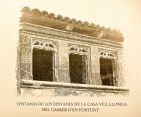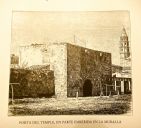
From Santa Eulàlia to the east
Comparisson reports are under license of:

Lo que dice el Arxiduc:
 "From Plaça de Santa Eulàlia, on the right, the twisty Carrer d’en Fortuny street begins. The Salvàs’ house is on the left, and the Villalongas’ house is on the right, with its small ogee arches in the attic and its eave. Over the main door’s lintel is the following inscription: “Priamus Villalonga”. The patio is triangular in shape and has a terrace with a columned parapet. On the capitals where the arches begin, we can read “Priamus Villalonga” on one and the saying, “Prudentia conjuges” on the other.
"From Plaça de Santa Eulàlia, on the right, the twisty Carrer d’en Fortuny street begins. The Salvàs’ house is on the left, and the Villalongas’ house is on the right, with its small ogee arches in the attic and its eave. Over the main door’s lintel is the following inscription: “Priamus Villalonga”. The patio is triangular in shape and has a terrace with a columned parapet. On the capitals where the arches begin, we can read “Priamus Villalonga” on one and the saying, “Prudentia conjuges” on the other.
We then come to the small plaza where the Montesión Church can be found. On the corner is a large house which, like the one in front of the church, has an open attic with a series of octagonal columns supporting an overhanging eave. To the right is the Montesión building. Carrer de Montesión extends along with Carrer del Seminari where, to the right, we see the public Seminari Conciliar building.
Carrer d’en Serra begins climbing steeply from Carrer de Santa Clara, then joining Carrer de la Portella after traversing under the large arch belonging to the Formigueras’ house. The houses here are simple, and only one has a semi-modern eave and attic with two octagonal columns. By contrast, in the garden of the modernized Morell Font i Roig house are some old ancient Arab baths, one of the few remaining Moorish vestiges on Mallorca. The baths form a square measuring 7 meters long on each side, with four columns with a 48-centimeter diameter on each side. The dome is made of brick with two series of four breathing holes each, though three in the lower row are blocked up. At the start of Carrer d’en Serra we see the Col.legi de la Puresa school whose main facade occupies a good part of Carrer de la Puresa. The latter street is divided by Pont i Vich street and ends in Carrer d’en Morey, with the side facade of the Count of Ayamans house. Though this side has been modernized, it still preserves Gothic windows on the first floor. Carrer del Beat Alonso, running almost parallel to Montesión Street, has to be considered as an extension of Carrer de la Puresa.
The entire neighborhood from Carrer d’en Berard which ends at Carrer Murada with a few steps and the blocks between Montesión and Seminari streets, including Plaça de Sant Jeroni, consist of many streets at the Calatrava and Campo gateways. These streets climb and fall as the terrain is very hilly.
The Calatrava neighborhood is known as that of the tanneries as the majority of tanners live on the street called “Curtidores”, that is, tanneries. At the end of the neighborhood, near the Porta del Camp gateway, is Plaça de Santa Fe in front of the chapel with the same name.
Carrer de Call street splits into two, the already mentioned Carrer Montesión and Carrer del Sol. The latter is long and narrow and features the city’s most interesting private buildings. At the start, on the left, is the house belonging to the Count of Santa Coloma. The very deteriorated exterior only preserves one Renaissance window and an eave atop a porch with octagonal columns. By contrast, its patio is very beautiful, though the stairs are partially destroyed. On the same side of the street is the Marquis of Palmer’s marvelous house, with its precious facade, the prettiest in the city, in the purest Renaissance style. Its windows are generally all similar, though their details differentiate them. The patio is very large. At the entrance, reached after crossing a half-point portal, are two smaller Renaissance portals on the right and left to reach the mezzanine floor. Other than that, the patio is fairly simple. The eave runs above a porch with octagonal columns. On the same side of the street we can see a couple of old homes with large, half-point portals, eaves and attics with octagonal columns.
Plaça de Sant Francesc is irregular in shape, with some trees planted in the middle. Only the area around it is paved. To the right of the church are the ruins of the old convent. From this plaza we can see Plaça del del Temple at the end of Carrer de Llull. To the right of the latter street is a house with a beautiful eave belonging to Mr. Fortuny. In the very simple entryway over two arches held up by pseudo-Ionic columns are the house’s coat of arms and the date, 1595. To the left is the new Carrer de Sant Bonaventura which still has no outlet.
Plaça del Temple is lined by poor houses. By contrast, the temple itself looks like a fortress. It was the residence of Templar Knights who owned vast properties on the island of Mallorca. This temple is one of the oldest buildings in the city of Palma though it has largely been destroyed.
Carrer de Sant Crist contains some new buildings except for the last one, number 20, belonging to the Marquis of Vivot. Its facade is simple. The entrance features a large, half-point portal, three balconies with iron grates and an attic with square columns. By contrast, the house’s patio is pompous and has to be considered one of the most beautiful inn Palma. The reddish, somewhat potbellied marble columns, with Roman capitals, hold up very flat arches. Four arches spread out from three of these columns. On one of the walls is another large arch which connects to the hallway with another side patio that has two large arches supporting a terrace. The latter features a balustrade decorated with five busts. This house forms a corner with Carrer de Zavellà street on which, exactly in front of the Marquis of Vivot’s house, is a mansion where, according to popular legend, Emperor Carlos V stayed incognito, a belief without any historical foundation whatsoever.
 Despite this, the house includes a magnificent, Renaissance-style window with a medallion bearing the Emperor’s bust as if to commemorate his stay there. Perhaps it is just the house owner’s expression of fidelity to Carlos V. The facade is very simple, with its half-point portal, balconies with iron handrail, attic with octagonal columns and eave.
Despite this, the house includes a magnificent, Renaissance-style window with a medallion bearing the Emperor’s bust as if to commemorate his stay there. Perhaps it is just the house owner’s expression of fidelity to Carlos V. The facade is very simple, with its half-point portal, balconies with iron handrail, attic with octagonal columns and eave.
Archduke Ludwig Salvator of Austria. Las Baleares por la palabra y el grabado. Majorca: City of Palma. Ed. Sa Nostra, Caja de Baleares. Palma de Mallorca. 1982.




















